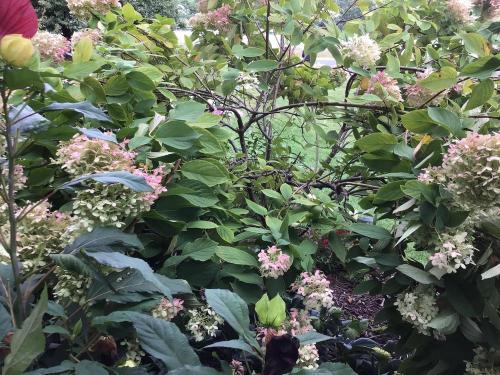It is common for panicle hydrangea (hydrangea paniculata) stems to arch or flop. The weight of the large, heavy, dense blooms helps make the stems top heavy so once you add the effect of windy conditions or storms that dump a lot of heavy rainfall (or snow), you have the perfect conditions for promoting this flopping problem at the end of the season.
Panicle stems can be brittle. In areas where there is risk of flopping due to the weight of heavy, wet snow or due to the weight of normal but significant amounts of snow, you can consider doing your pruning program early in the fall or you can also only deadhead the spent blooms now and do the pruning later. To deadhead, prune above the first pair of leaves.
Except for helping minimize stem breaks in scenarios like yours, there is usually no significant difference between not pruning, pruning in early fall (September 23rd or later), in late winter or in very early spring (while still dormant or just starting to leaf out).
Be aware that thin, green stems tend to be weaker than woody stems so while pruning, minimize cutting woody parts of the stems (consider cutting only about 1/3 or less of each stem's length). Smaller, more compact cultivars tend to flop less. So do some -not all- new plantings at first. Cultivars with lacier blooms like Pinky Winky, Brussels Lace, Burgundy Lace, Chantilly Lace and any others with the word "lace" in the name will develop blooms that have less sepals, weigh less and that helps minimize flopping. Staking of thin stems can help avoid flopping. Planting the shrub in between two other plants or against a fence/wall can help mitigate the problem as stems get some support versus planting the hydrangea by itself. After stormy weather in the summer, consider shaking off the water from the dense blooms.
Standard panicle hydrangeas (tree hydrangeas) tend to have this issue too, as they are typically sited in the middle of the landscape by themselves with no wind block. They can flop in winter significantly due to the weight of snow. Large branches and even the main trunk can be injured if the weight of snow is too heavy. If there is an injury, you may end with a tree lacking foliage in certain areas, which unfortunately makes the tree unstable (it needs tree stakes to avoid toppling when windy) or is not "aesthetically pleasing" and eventually needs to be replaced. Damage to the trunk of a panicle tree hydrangea may require giving up on the tree form and growing the panicle hydrangea in shrub form instead . Or you may have to get a new tree.
